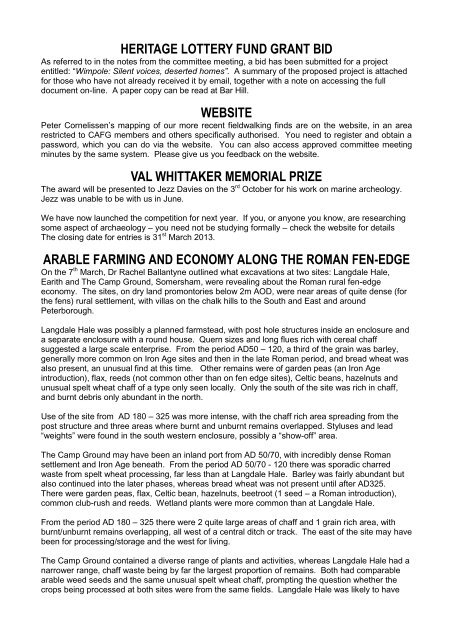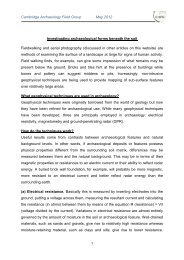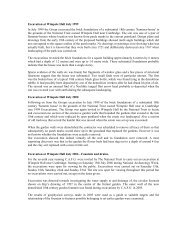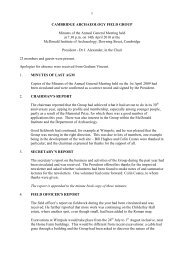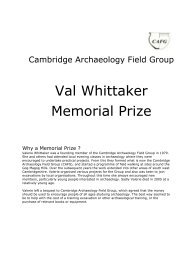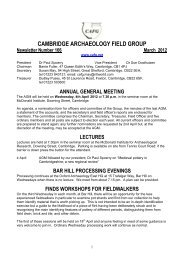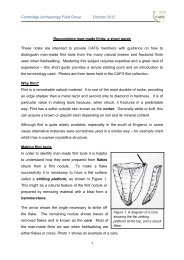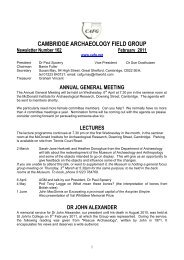CAFG newsletter 168 - Cambridge Archaeology Field Group
CAFG newsletter 168 - Cambridge Archaeology Field Group
CAFG newsletter 168 - Cambridge Archaeology Field Group
You also want an ePaper? Increase the reach of your titles
YUMPU automatically turns print PDFs into web optimized ePapers that Google loves.
HERITAGE LOTTERY FUND GRANT BID<br />
As referred to in the notes from the committee meeting, a bid has been submitted for a project<br />
entitled: “Wimpole: Silent voices, deserted homes”. A summary of the proposed project is attached<br />
for those who have not already received it by email, together with a note on accessing the full<br />
document on-line. A paper copy can be read at Bar Hill.<br />
WEBSITE<br />
Peter Cornelissen’s mapping of our more recent fieldwalking finds are on the website, in an area<br />
restricted to <strong>CAFG</strong> members and others specifically authorised. You need to register and obtain a<br />
password, which you can do via the website. You can also access approved committee meeting<br />
minutes by the same system. Please give us you feedback on the website.<br />
VAL WHITTAKER MEMORIAL PRIZE<br />
The award will be presented to Jezz Davies on the 3 rd October for his work on marine archeology.<br />
Jezz was unable to be with us in June.<br />
We have now launched the competition for next year. If you, or anyone you know, are researching<br />
some aspect of archaeology – you need not be studying formally – check the website for details<br />
The closing date for entries is 31 st March 2013.<br />
ARABLE FARMING AND ECONOMY ALONG THE ROMAN FEN-EDGE<br />
On the 7 th March, Dr Rachel Ballantyne outlined what excavations at two sites: Langdale Hale,<br />
Earith and The Camp Ground, Somersham, were revealing about the Roman rural fen-edge<br />
economy. The sites, on dry land promontories below 2m AOD, were near areas of quite dense (for<br />
the fens) rural settlement, with villas on the chalk hills to the South and East and around<br />
Peterborough.<br />
Langdale Hale was possibly a planned farmstead, with post hole structures inside an enclosure and<br />
a separate enclosure with a round house. Quern sizes and long flues rich with cereal chaff<br />
suggested a large scale enterprise. From the period AD50 – 120, a third of the grain was barley,<br />
generally more common on Iron Age sites and then in the late Roman period, and bread wheat was<br />
also present, an unusual find at this time. Other remains were of garden peas (an Iron Age<br />
introduction), flax, reeds (not common other than on fen edge sites), Celtic beans, hazelnuts and<br />
unusual spelt wheat chaff of a type only seen locally. Only the south of the site was rich in chaff,<br />
and burnt debris only abundant in the north.<br />
Use of the site from AD 180 – 325 was more intense, with the chaff rich area spreading from the<br />
post structure and three areas where burnt and unburnt remains overlapped. Styluses and lead<br />
“weights” were found in the south western enclosure, possibly a “show-off” area.<br />
The Camp Ground may have been an inland port from AD 50/70, with incredibly dense Roman<br />
settlement and Iron Age beneath. From the period AD 50/70 - 120 there was sporadic charred<br />
waste from spelt wheat processing, far less than at Langdale Hale. Barley was fairly abundant but<br />
also continued into the later phases, whereas bread wheat was not present until after AD325.<br />
There were garden peas, flax, Celtic bean, hazelnuts, beetroot (1 seed – a Roman introduction),<br />
common club-rush and reeds. Wetland plants were more common than at Langdale Hale.<br />
From the period AD 180 – 325 there were 2 quite large areas of chaff and 1 grain rich area, with<br />
burnt/unburnt remains overlapping, all west of a central ditch or track. The east of the site may have<br />
been for processing/storage and the west for living.<br />
The Camp Ground contained a diverse range of plants and activities, whereas Langdale Hale had a<br />
narrower range, chaff waste being by far the largest proportion of remains. Both had comparable<br />
arable weed seeds and the same unusual spelt wheat chaff, prompting the question whether the<br />
crops being processed at both sites were from the same fields. Langdale Hale was likely to have


